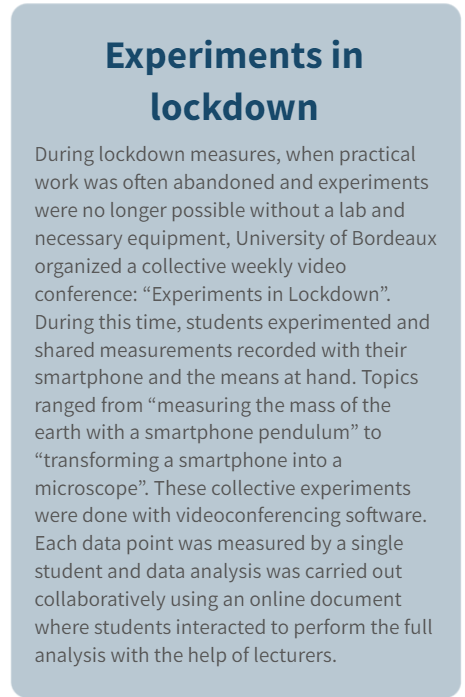2nd Position: From autonomous “Do It Yourself” lab work towards collaborative
and peer learning experiments
Course Summary:
The SMARTPHONICS course involved students using their smartphones to carry out science experiments autonomously, benefiting from the ease and rapidity of smartphone-based experimentation. During the course, they worked together in groups of four to complete four experimental activities, including an extension project of their choice. The experiments focussed on several topics, such as resonance of a string or measurement of sound speed using the Doppler effect. Students created and improved experimental protocols, learnt through peer collaboration, and submitted reports that include both experimental and theoretical aspects. The extension projects covered diverse subjects and students could access resources like MOOC videos to aid their work. The best presentations were displayed in a final session.
Course Design:
The SMARTPHONICS experiments were organized to address a massive group of 350 students, requiring a collaborative teaching team. Students were divided into 11 groups and these groups were being taught by 11 teachers in parallel. The experiments were linked to the theoretical concepts of the course, helping students to better understand practical applications of theory.
The structure of the course involved students having two weeks to prepare experimental activities related to a course topic. During the preparation period, students could seek guidance from their teachers to refine their protocols and analyses.
Using smartphones for scientific experiments offered unique advantages. Smartphones allowed exploration of diverse themes that might be challenging with standard lab equipment, as they have various sensors not found in typical lab rooms. Additionally, the integration of practical experiments and its theory courses became more manageable, resolving the issue of many students and limited lab space. These smartphonic experiments could be conducted both before and after courses to reinforce theoretical concepts or even during class to create an experimental active hybrid environment.
Feedback from students was overwhelmingly positive, with over 85% finding the practical work interesting, and 25% finding the use of smartphones in science, fun and enjoyable. Students tackled complexity of using multiple applications with different data exports by use of specialized apps, like Physics Toolbox Suite or PhyPhox, that further simplified the process.
Apart from scientific skills, the smartphonic experiments also helped students develop essential soft skills, such as teamwork and creativity. The integration of smartphones into education not only motivated students but also made them more active participants in their learning process.
In the following video, you can watch designers of the course explain their motivations, processes and experiences of implementing the course.
Contact person:
Prof. Ulysse Delabre
